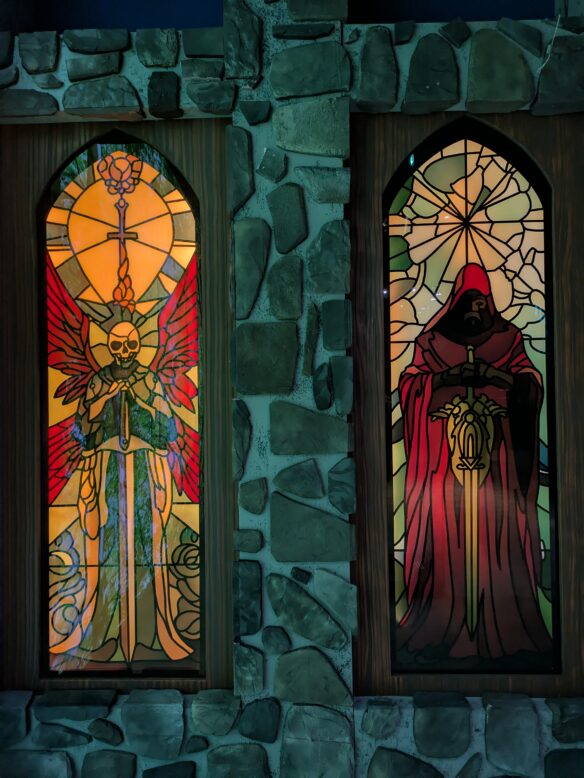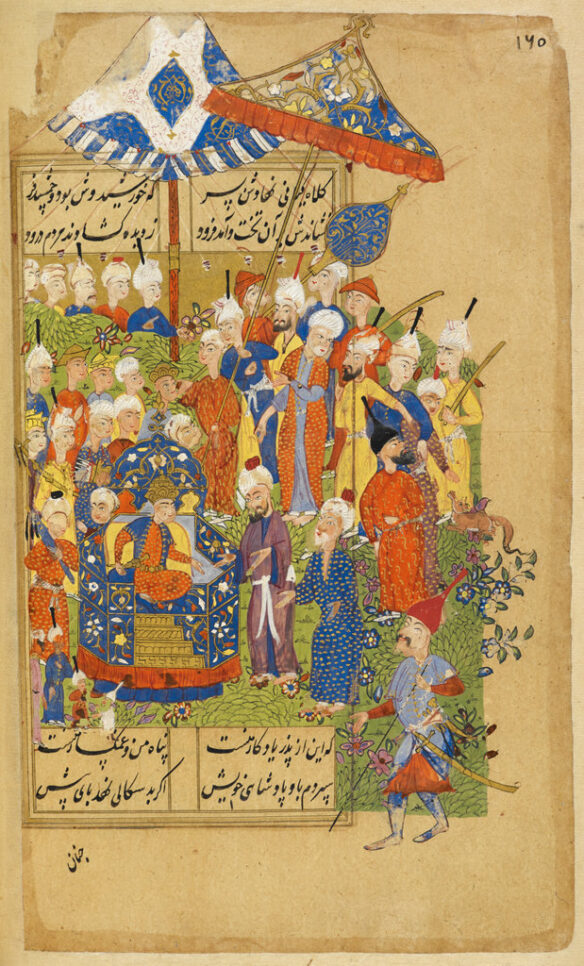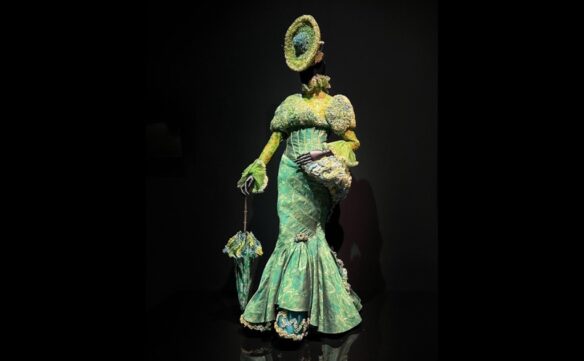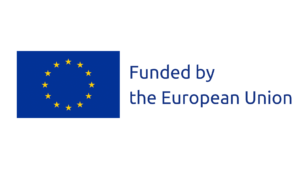
By Arendse Lund: In a sprawling celebration of the oldest story-telling genre of them all, the British Library’s exhibition Fantasy: Realms of Imagination captures visitors with tales of elves and dragons, actions and consequences, and how humans make sense of the world. First curated and hosted by the British Library (27 October 2023 – 25 February 2024), the exhibition is now on tour, having recently closed out a stint at the Bowers Museum in Santa Ana (26 October 2024 – 19 January 2025).
The exhibition comes at an exciting time. According to the trade magazine The Bookseller, sales of science fiction and fantasy novels were up 41.3% between 2023-2024, setting a record for the genre. This was largely driven by the popularity of authors such as Sarah J. Maas and Rebecca Yarros, both of whom have sold millions of books. Demand for stories of faeries and dragons isn’t new, but it is enduring, and that’s what the Fantasy exhibition is here to remind us of.

Walking through the exhibition is akin to celebrity sightseeing, where there’s yet another heavy hitter around each corner. The exhibition stretches temporally and geographically to document the abiding cultural appeal of fantasy literature. Some of the highlights on display include a Persian manuscript of Sinbadnama, the Story of Sinbad, a sketch from Arabian Nights, and Seamus Heaney’s translation of the Old English epic poem Beowulf.

More recent additions to the fantasy genre include Christina Rossetti’s iconic Goblin Market and Other Poems (1862), with an accompanying illustration done in typical Pre-Raphaelite fashion by her brother, Dante Gabriel Rossetti. There’s also a copy of the Swedish edition of J.R.R. Tolkien’s The Hobbit (1962), illustrated by Moomin creator Tove Jansson; her giant, troll-like drawing of Gollum upset readers and spurred Tolkien to describe the character as “small” in later editions. There’s even the notebook with Ursula K. Le Guin’s original handwritten draft of A Wizard of Earthsea (1968), the novel that introduced a wizarding school to the world — an idea that’s seen great success since then. In contrast to the draft version of Le Guin’s work, there’s a spiraling display of the 16 published books in Robin Hobb’s Realm of the Elderlings Series (1995-2017), and editions of Fantasy & Science Fiction and other short fiction magazines.

These are works that influenced writers and authors across genres, and remind us how expansive the fantasy genre is. After all, books and stories in these rooms have sold nearly countless copies and inspired writers and readers throughout the years. Thanks to this, the Bowers Museum had a lot of room to add their own contributions on top of the objects and themes established by the British Library in the original exhibition. For instance, the Bowers Museum created four hand-designed and printed stained glass panels, in addition to a castle composed of over 500 handmade foam rocks. There was also an Alice in Wonderland card sculpture and a Happily Ever After banner, which all served to establish a fantastical ambiance and set the scene for a journey through a fantasy realm.
However, for a topic that relies so heavily on human creativity, it’s disappointing that, rather than partner with visual artists themselves, the museum decided to generate AI videos and images. The videos, filled with visual inconsistencies typical of AI, felt incongruous next to the beautiful works on display. On one screen, blotchy figures walked past storefronts boasting broken text and down a dubiously Victorian-inspired street made up of fractured tiles. What was the point?
There are numerous, well-known downsides to AI, a technology that is trained off of actual artists’ works and used to regurgitate different shapes of those artworks at the prompting of a user. The U.S. Copyright Office has consistently ruled that art generated by a prompt can’t be copyrighted since it’s not original, even if a user goes through multiple iterations of a work before settling on a final product. There are multiple ongoing lawsuits regarding image generation companies violating copyright, or removing or alternating artists’ copyright management information. Even setting aside these legal and moral minefields, the environmental impact of the technology is also huge. At a time when nearly a quarter of California is battling a severe drought, and wildfires have become an annual and frightening occurrence across the state, there’s no need to rely on a technology that consumes additional fresh water and strains existing grid infrastructures. In fact, thanks to those very same wildfires that swept across Orange County, the Bowers Museum announced an early closure of the Fantasy exhibition to ensure the safety of the art.
So why add AI-generated content to an otherwise well-rounded exhibition? Perhaps the answer is as simple as an enthusiasm for new technology. But all the phenomenal works on display — including the Bowers’ own handmade additions that decorated the exhibition like a theatre — made the contrast with the AI-generated pieces all the sharper.

In many ways, the AI was the only shortcoming to a remarkable exhibition showcasing the breadth and depth of human creativity. For anyone who missed the exhibition (or anyone wanting to go again), we’ll have to hope that the exhibition reopens elsewhere so that visitors can continue to admire the first-edition novels, manuscripts, and costumes that all combine to make the exhibition visually and historically striking.

Arendse Lund is an award-winning author whose fiction and poetry has appeared in Analog Science Fiction & Fact, Shotgun Honey, Mystery Magazine, and The Fabulist, among others. Her short story, “The Toll Bridge,” won the 2021 Staunch Prize for horror writing. Her world building has been called “vividly imagined and genuinely creepy,” which is the highest praise she can imagine. In 2015, she served as the Writer-in-Residence at Elsewhere, Colorado, and from 2023-2024, at the Seattle Public Library. She is currently a Marie Curie Postdoctoral Fellow at the Arnamagnæan Institute at the University of Copenhagen.
Her journal articles and translations have appeared in international publications, including Scandinavica: An International Journal of Scandinavian Studies, Alchemy: Journal of Translation, and the volume Law and Literature in Early Medieval England. She earned her doctorate researching medieval manuscripts and the law at University College London. She specializes in the overlap between law and literature throughout the Middle Ages, especially England and Scandinavia. She has taught classes and guest lectured at University College London, NYU, and the Arnamagnæan Institute.
In 2019, she was awarded the Association of British Science Writers’ top award for her work on Researchers in Museums. You can contact her at www.arend.se
